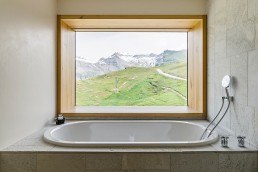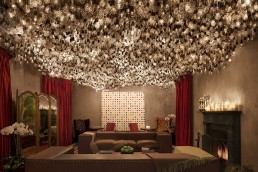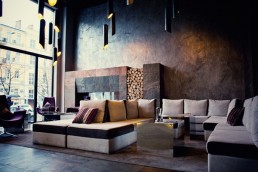Meeting… Arnaud Zannier
For most new hoteliers, early success lies in focusing on a specific market; building a portfolio in a select location – be it city, country or continent – before expanding horizons and looking to opportunities further afield. Not for Arnaud Zannier. The founder of Zannier Hotels, which only launched its first property in 2011, has taken a somewhat unorthodox approach, flitting between mountain, city, paddy field and savannah to open what is now a four-strong portfolio spanning four countries and three vastly different continents.
“The way we open hotels is unusual to a lot of people,” admits Zannier, as we meet in London on one of his regular visits to the city. “We started in the Alps, then went to Southeast Asia; from there we came back to a secondary city in Belgium, and now we’re opening in Africa. But that’s what we like to do; we like to create new things.”
With an entrepreneurial spirit, Zannier has spent much of his working life creating new concepts. The son of French fashion industrialist Roger Zannier, he studied in Switzerland and Paris, before making his mark on the family business, developing the Kickers shoes brand at an international level. In 2001, the then 28-year-old went solo, launching his own footwear company built on the principles of simplicity, quality, originality and constructional know-how – values that have gone on to serve him well in the hospitality world.
Zannier’s true calling came in 2010, when his father requested he return to the family fold, fast approaching its 50th anniversary and gaining a reputation for childrenswear, having created ranges for the likes of Kenzo Kids, Junior Gaultier and Paul Smith Junior.
“I didn’t want to come back and work in the family’s fashion group because I felt there was nothing I could do better than what they were already doing,” he explains. “I already had some ideas for hospitality and identified a niche in which the future of luxury is more about moments and experiences than gold taps and marble.”
With the backing of his father, Zannier invested in a three-Michelin-star restaurant in the French village of Megève, purchasing adjacent land to build an extension and create Le Chalet. “The project was kind of a lab for me to start this hospitality idea,” he continues. “It was small, but as it was our first one, we said let’s start small and see how it goes.”

The venture was risky. The positioning was way above anything else in the village at that time; each suite was designed as an authentic Alpine chalet – the largest featuring two bedrooms, a lounge with open fireplace and a balcony with views of the mountains – and the staff-to-room ratio particularly high with 40 employees for 12 keys.
But it paid off. “The product worked very well from day one. It’s been seven years since the opening of our first hotel, and in that time our idea has grown,” he continues. The group’s second hotel opened in Cambodia in 2015, and was the one to really put Zannier Hotels on the map. Built amongst rice paddies on the outskirts of Siem Reap, Phum Baitang is designed as an authentic Cambodian village, with 45 stilted villas dotted across eight hectares of land, along with an outdoor infinity pool, two restaurants, and a cocktail bar housed within a 100-year-old Khmer farmhouse. Rustic materials such as wood and stone combine with local building traditions and indigenous vegetation for a truly authentic experience; and then there’s the resident water buffalo that roam freely on the site. “It’s a true experience of being in the countryside in Cambodia, that’s what we love at Zannier Hotels,” he notes.
So why Cambodia? “As a family we have a foundation in Cambodia and have been financing an orphanage there for a number of years,” he explains. “We were also investing in land, so when I decided to go into the hospitality industry, my father suggested I have a look at the portfolio. Siem Reap is the number one destination in Cambodia and a lot of the hotels are within colonial buildings in town. When I saw this beautiful piece of land I knew it would be perfect to create something very different.”
Phum Baitang came to the attention of the world’s media when Hollywood actress Angelina Jolie spent three months at the resort while filming in the country. It has also won Zannier a cabinet full of awards, with the property scooping the top accolade at the 2016 Asia Hotel Design Awards.
The design of Phum Baitang, and all of the group’s hotels, is very much a personal vision. While Zannier has no formal qualifications in design, he’s a man with taste. “I have a specific idea of what I like, and what I want as a customer, or what I would like to experience as a guest,” he explains. “I’m lucky enough to have a family who can finance my ideas and projects, so I create hotels to my taste and and have found that there’s people who apparently like the same thing.”
However this isn’t a vanity project. “Our hotels are profitable,” Zannier counters. “It’s not something I mention too often, but this is business and our hotels are successful. Every property that we’ve opened has been profitable within year one, which in the luxury market is rare.”

© Alex Stephen Teuscher
It’s not a numbers game either. Zannier has a palpable passion for hospitality and has built a small and trusted team, the longest serving of which have been with him since day one. Executive chef Julien Burlat is a childhood friend and has developed the F&B concept for each property, his responsibilities spanning from the sourcing of local suppliers to designing menus and training kitchen crews. Interior designer Geraldine Dohogne meanwhile has been instrumental in creating the unique look and feel of the brand. Having started out as Zannier’s assistant in 2008, she now oversees the projects from concept to completion, taking in architecture, interiors and procurement. “I recruited Geraldine when I bought the first hotel in Megève,” Zannier explains. “I was busy with my fashion business and needed someone to help manage the refurbishment. We worked together on the project and gradually she has developed an eye that is very similar to mine.”
Like Zannier, Dohogne doesn’t have a background in hotel design, but the pair work closely to ensure each property follows the brand mantra of ‘simplicity is the ultimate sophistication’. “It’s all about creating an atmosphere for guests to remember individual moments,” explains Zannier. “Of course there’s a DNA, but we want each hotel to be unique; that’s very important to us. It would be a shame for guests to travel the world and always feel the same.”
All feature the use of local materials, and there’s a combination of modern and traditional construction techniques, always keeping in mind environmentally-friendly approaches and knowledge of the vernacular. “Zannier Hotels is about trying to recreate an atmosphere from a period or culture, and we’re always inspired by what we find on site,” he continues. “The idea is to be true to the culture, to the country, to the environment and to the building. At Phum Baitang we decided to recreate the villages living around the paddy fields, and at 1898 The Post we worked around the origin of the building, a post office, bringing the ambiance of that period.”
1898 The Post is the group’s second property in Europe, making its debut in 2017 in the city of Ghent. As with other hotels in the portfolio, the team immersed themselves in local culture and history of the building, creating stories and enhancing architectural details of the Neo-Gothic landmark. Rich colours, natural textures and materials that better with age take centrestage and continue a commitment to purity and authenticity.
Zannier’s latest venture has taken him to Namibia, where a luxurious lodge overlooking a private reserve opened its doors just a few of months ago. Located close to Windhoek, it’s yet another unconventional addition to the portfolio, and one that came about through an unlikely connection. “Nothing was planned, we’ve been lucky,” quips Zannier, explaining that it was Angelina Jolie who told him about her friends’ reserve, and the help needed to continue their mission of protecting wildlife in the area. “She told me to go and visit this couple because there was land for sale close by,” he continues. “So I flew to Namibia to meet them and we became friends. They’re good people, so that’s when I decided to buy and continue the Zannier Hotels adventure in Africa.”

Since this first meeting, Zannier has become immersed in the country, and consequently the project has snowballed into a multi-site development. “When I discovered the country I realised that it’s so diverse and we’d need at least three to four lodges for people to discover the culture and landscape,” he continues. Inspired by the traditional architecture of the Owambo people, Omaanda is the first in a series of lodges to open across the country, and once again takes the brand into new territory. It will offer safaris in the newly formed Zannier Reserve, and support the Shiloh Wildlife Sanctuary, a clinic for injured rhinos and elephants. Further properties are planned for Sossusvlei in the desert, Etosha to the north, and in the Caprivi region, close to Okavanga Delta. A mobile camp is also in the works, journeying between the sites for a cross-country adventure.
Elsewhere there’s talk of an extension at Phum Baitang, a new venture in Vietnam, and aspirations to head west to the Americas. The Vietnam project is under construction and is set to feature 71 beach huts lining a private bay in Phu Yen province. Slated to open in 2020, it marks the group’s largest project in terms of investment and will also test its real estate potential, with 45 villas available for purchase.
As for the US, Zannier believes that, despite the overcrowded luxury sector, the group can bring something new. “We know that 30% of our guests at Phum Baitang for example are coming from the USA; I’m sure that our DNA is different enough and will create something really fresh for the US market.
“After Vietnam we have another potential project in Southeast Asia and we’ve just had a request from Central America, which is interesting because it’s another continent and could be a door to the US market,” Zannier continues, before revealing that the site is in fact in Mexico, and he’s headed there in a matter of weeks.
While expansion is clearly on the cards – the group is slated to double its room count over the next three years – Zannier is mindful of taking on too many projects. “We’re a small team and we enjoy what we do,” he notes. “I don’t want to expand too quickly otherwise we risk losing the spirit of the brand.”
He isn’t interested in copy-and-paste concepts either, and with each project so deeply rooted in its locale, growth will likely be slow and steady. To emerge from hotel industry novice to established global brand is an achievement in itself, but the hotelier doesn’t make it easy, selecting vastly different locations and having to learn the complexities of development, ownership and operations in each market before construction even begins. But for Zannier, that’s part of the appeal. His sites are selected for their untamed beauty and rich heritage rather than ease of doing business. “The adventure is not the end product, but the process of finding a new destination, creating a concept and finding solutions to the challenges and difficulties,” he concludes. “I learn a lot with every project and that’s what makes it exciting.”
Words: Catherine Martin
Images: Courtesy of Zannier Hotels (unless otherwise stated)
This piece originally ran in Sleeper 81
Related Posts
29 October 2018
Axor partners with Design Hotels
4 March 2016
Design Hotels and SPG join forces
3 December 2012
Design Hotels opens first Ukrainian property
1 Comment
Comments are closed.





[…] Zannier saw Le Chalet as his chance to test the premise he’d been kicking around, the idea that “the future of luxury is more about moments and experiences than gold taps and marble.” Le […]